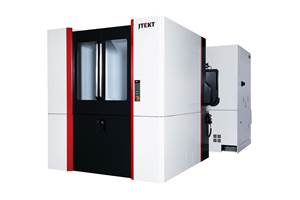What Shops Want In Machining Centers
This study summarizes a few of the findings in a newly released report on CNC machining center buyers. The 233-page report focuses on the perceptions and priorities of this group
The price of replacement parts is more important to machining center buyers than the machine's purchase price.
Just under half of machining center buyers assign high importance to shopfloor programming capability.
Only about a quarter of machining center buyers rank remote diagnostics via the Internet as a highly important feature.
These statements summarize a few of the findings in a newly released report on CNC machining center buyers. The 233-page report focuses on the perceptions and priorities of this group.
Titled “Machining Center User Perception Study,” the report is based on a survey conducted by Bull’s Eye Marketing (Fond Du Lac, Wisconsin), an industrial market research company. Survey targets were individuals with engineering or engineering management titles who have authority for specifying machining centers. The report’s findings are based on 333 responses to the detailed survey, which translates to a statistical margin of error of ±4.5 percent, the company says.
In addition to gaging buyers’ perceptions of machining center features, the survey also asked about machining center manufacturers. Respondents were invited to evaluate any of 99 machining center vendors in terms of product quality and quality of service. Only eight companies received evaluations (good or bad) from 200 or more respondents, suggesting that these are the eight vendors shops are most familiar with: Bridgeport, Cincinnati Machine, Fadal, Haas, Hardinge, Mazak, Mori Seiki and Okuma.
The mailing list for the survey was obtained from this magazine. The pool of respondents covers a variety of metalworking businesses and industries. Out of 15 possible categories (respondents could select more than one), 28 percent reported working for job shops, 18 percent said they work in the automotive industry, 14 percent work in the plastics and rubber industry, and 11 percent work in aerospace.
About 60 percent of respondents work at a facility with 100 or more employees. Forty percent reported working at a facility that spends at least $250,000 per year on machine tools and related products.
The median number of vertical machining centers across all of these facilities is four. The median number of horizontals is three. In the cases of both types of machines, the average number was much higher because a few big facilities skewed the results. (One responding facility had 160 horizontals, for example.) The average age of these machines is about 8 years. For horizontals and verticals both, that number is about the same.
To evaluate what buyers look for when they contemplate buying a new machine, the survey asked respondents to rate 33 machining center characteristics on a five-point scale from not important to very important. The characteristics included features of the machine itself such as accuracy, thermal stability and CNC functionality, as well features of the vendor including turnkey capability, telephone support and quality of the salespeople.
To rank these characteristics, the surveyors counted how many respondents rated each characteristic above average in importance. That is, how many respondents gave the characteristic either the highest or second-highest rating on the five-point scale.
Machine reliability and performance of machine both were given the highest or second-highest rating by 97 percent of respondents. These two characteristics tied for first place. The following characteristics also received above-average scores from 90 percent of respondents or more: cutting accuracy (94), availability of replacement parts (92), vendor resolves problems in a timely fashion (91) and factory service and support (90).
For the complete ranking of characteristics, CLICK HERE.
Price of machine ranked 19th, or relatively low on the list. It was rated above average in importance by 57 percent of respondents. Among the characteristics that beat it was price of replacement parts at 60 percent. This is the basis for the statement that the price of replacement parts is more important to machining center buyers than the price of the machine itself.
Tom Bullock is president of Bull’s Eye Marketing. He says he finds other surprises in the results, including the 47-percent score for shop floor programming capabilities. He thinks this characteristic would have scored much higher 10 years ago. “The lights-out factory concept may be changing the importance of operator flexibility,” he says.
Another surprise is the score of 26 percent for remote diagnostics. He expected this to do better. “There’s been a lot written about using the Web to remotely diagnose machine problems to save field service costs,” he says. “So far, the attention hasn’t had that great an impact on users.”
Related Content
JTEKT Launches New Series of HMCs
The new FH5000 series machines include a 500-mm table capable of handling 1,000-kg loads.
Read MoreLean Approach to Automated Machine Tending Delivers Quicker Paths to Success
Almost any shop can automate at least some of its production, even in low-volume, high-mix applications. The key to getting started is finding the simplest solutions that fit your requirements. It helps to work with an automation partner that understands your needs.
Read MoreVolumetric Accuracy Is Key to Machining James Webb Telescope
To meet the extreme tolerance of the telescope’s beryllium mirrors, the manufacturer had to rely on stable horizontal machining centers with a high degree of consistency volumetric accuracy.
Read MoreThe Debut of an HMC Series
The FH5000 Series from JTEKT Toyoda is compromised of three high-speed horizontal machining centers.
Read MoreRead Next
The Cut Scene: The Finer Details of Large-Format Machining
Small details and features can have an outsized impact on large parts, such as Barbco’s collapsible utility drill head.
Read More3 Mistakes That Cause CNC Programs to Fail
Despite enhancements to manufacturing technology, there are still issues today that can cause programs to fail. These failures can cause lost time, scrapped parts, damaged machines and even injured operators.
Read More
.jpg;width=70;height=70;mode=crop)






.jpg;maxWidth=300;quality=90)


















.jpg;maxWidth=970;quality=90)